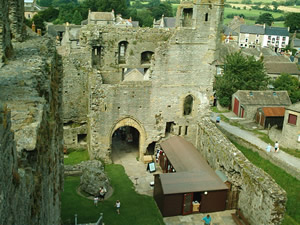Middleham Castle

Looking back down to the gatehouse
View map (SE 128 876): Multimap | Google | Live Local
Middleham castle dates from about 1170s when Ribald Fitz Ranulf built it to replace the nearby earthwork known as William's Hill (this earthwork itself dates from soon after the Norman conquest, probably built by Alan the Red, and is still visible from the castle). The main part of the castle consists of a large hall keep, over 100 feet long but of only one main floor with the undercrofts below. The current modern, external wooden staircase follows the line of the original stone stairs (which would have been protected by a further wall on the outside). This allows one to observe a guardroom built into the side of the keep about half way up. Here a gate would have protected the stairway (another gate was present at the foot of the stairs). A third gate was positioned at the top of the stairway, which gave access to an ante-room outside the main door of the keep.
The keep was divided by a cross wall running its length. The main floor contained the great hall (access directly from the ante-room at the head of the stairs), with pantry and buttery on the eastern side and two large chambers to the west of the cross wall. The larger of the two western chambers was accessed from the great hall. It had its own fireplace and latrine. By the side of the doorway leading to the latrine was a sone wash basin. This latrine was housed in a projecting tower, also accessable from the smaller chamber (which also had a fireplace).
The undercroft is in poor state but the base of the columns forming an arcade running down the centre of the undercroft beneath the hall are still apparent. A fireplace set in the cross wall marks where the kitchen was housed (now split east/west the fireplace would originally have been one open hearth. A drain may be seen cut through the south wall near the floor. Entrance to the undercrofts was via a spiral staircase in one of the angle turrets. The other angle turrets provided small chambers at first floor level. Latrines were situated in projections at the centre of two sides of the keep. The basement also contained not one but two wells.
In 1270 the Nevilles acquired Middleham and it was Ralph Neville who enlarged it around 1300. He was responsible for the close curtain around the keep, forming in effect a concentric quadrangular castle. While this design is reminscent of the military architercural advances shown in Edwardian Welsh castles it is let down by the rectangular, barely projecting towers at the angles. The original entrance was through a gate tower in the centre of the east side. Like most of the eastern curtain this is now ruined to its foundations. It was connected to the keep by a chapel block, also ruined.
In the fifteenth century the castle was again modernised. A new solar was created above the main hall in the keep (the corbels which supported the original roof are still discernable beneath the new stone work). The curtain wall was also heightened to accomodate the accomodation built against it on three sides (resulting in an even narrower corridor remaining between curtain and keep). Bridges linked the south and west ranges to the first floor of the keep. The north-eastern corner tower was transformed into a gate tower (the current entrance) with a vaulted gate passage and row of machicolation corbels at the top. Evidence may still be seen of the great wooden doors and portcuillis which protected this entrance way. A bridge spanned the ditch from this entrance to a small outer tower and possibly a courtyard.
Middleham later formed the northern power-base of the second Richard Neville, the "Kingmaker" and it was here he held Edward IV prisoner in 1469. The castle was the youthful home of Richard, Duke of Gloucester, the future Richard III, where he lived under the care of Richard Neville. Upon Richard Neville's death at Barnet in 1471 the castle passed to Richard. Richard son, Edward, was born at Helmsley and also died their aged only 11. The castle fell into decay after Richard's short reign ended with his death at Bosworth in 1485.
Sources:
- Personal visit
- A. Pettifer, English Castles: A Guide by Counties, Boydell & Brewer, Woodbridge (1995) ISBN: 0 85115 782 3
- N. Harris, Castles of England, Scotland and Wales, George Philip, London (1991) ISBN: 0 7537 0753 5